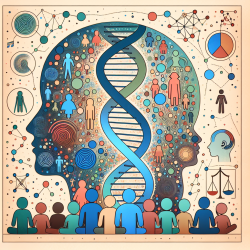Introduction
In the ever-evolving field of neuroimaging and therapy, the integration of machine learning with advanced imaging techniques has opened new avenues for predicting and managing neurological disorders. The research article titled "Improved prediction of glioma-related aphasia by diffusion MRI metrics, machine learning, and automated fiber bundle segmentation" by Shams et al. offers groundbreaking insights into predicting aphasia in patients with gliomas. This blog explores how practitioners can leverage these findings to enhance their diagnostic and therapeutic skills.
Understanding the Research
The study focuses on predicting aphasia, a language disorder, in patients with gliomas affecting the language network. By utilizing diffusion MRI (dMRI) metrics and machine learning algorithms, the researchers achieved an impressive 81% accuracy in prediction. The study involved 78 patients with left-hemispheric perisylvian gliomas, and aphasia was graded using the Aachen aphasia test (AAT).
Key Findings
- The most effective dMRI-based metrics were fractional anisotropy (FA), apparent diffusion coefficient (ADC), and axial diffusivity (AD).
- Critical fiber bundles identified were the arcuate fasciculus (AF), middle longitudinal fasciculus (MLF), and inferior fronto-occipital fasciculus (IFOF).
- Machine learning models, particularly support vector machines (SVM) and random forest algorithms, were instrumental in feature selection and prediction.
Implications for Practitioners
For practitioners, the integration of these findings into clinical practice can significantly enhance the prediction and management of aphasia in glioma patients. Here are a few ways to implement these insights:
- Adopt Advanced Imaging Techniques: Incorporate diffusion MRI metrics into routine diagnostic protocols to better understand the structural connectivity of the brain.
- Utilize Machine Learning Models: Train and apply machine learning algorithms, such as SVM and random forest, to improve the accuracy of aphasia predictions.
- Focus on Key Fiber Bundles: Pay particular attention to the AF, MLF, and IFOF during imaging analysis, as they are crucial in predicting language impairments.
Encouraging Further Research
The study by Shams et al. is a stepping stone in the realm of neuroimaging and machine learning. Practitioners are encouraged to delve deeper into this research area to refine prediction models and explore additional applications. Collaborations with data scientists and neuroimaging specialists can foster innovative approaches to tackling aphasia and other neurological disorders.
Conclusion
The integration of diffusion MRI metrics and machine learning in predicting glioma-related aphasia marks a significant advancement in the field. By embracing these technologies, practitioners can enhance their diagnostic capabilities and improve patient outcomes. As we continue to explore the intersection of technology and healthcare, the potential for innovative solutions in therapy and diagnosis is boundless.
To read the original research paper, please follow this link: Improved prediction of glioma-related aphasia by diffusion MRI metrics, machine learning, and automated fiber bundle segmentation.










